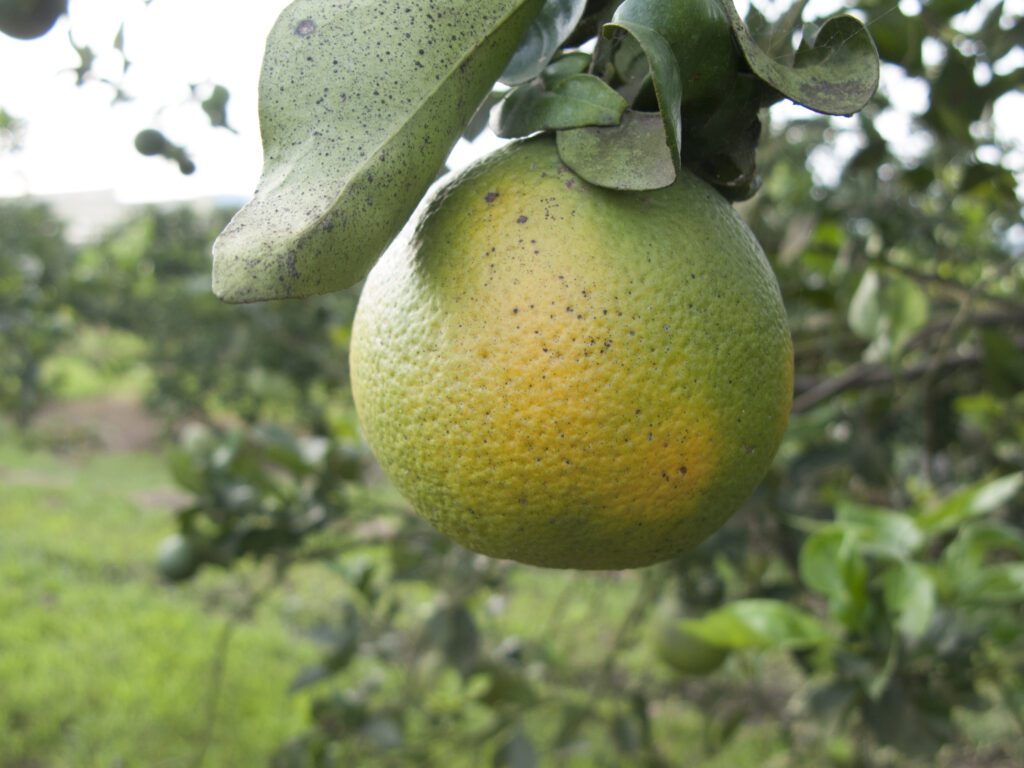Promising Trunk Injection Results Show Increased Size, Better Juice Quality, and Lower Fruit Drop Rate
by TIM CRAIG
The Florida citrus industry is approaching its 20th year of greening with a glimmer of hope as new research results from trials of trunk injections have yielded positive results and may have provided the industry with a path forward.
“Growers have told me that this is the best response to anything that has come down the pike,” says Rick Dantzler, Chief Operating Officer of the Citrus Research and Development Foundation. “Not all experiences have been the same, but most everyone who has participated has seen a positive response.”
At the center of the latest results is Dr. Ute Albrecht, Associate Professor of Plant Physiology at the Southwest Florida Research and Education Center in Immokalee. Albrecht has spent much of her career studying citrus rootstocks.
“Growers have known that HLB is a bacterial pathogen and the best way to treat a bacterial infection is with antibiotics,” says Albrecht.
The approach was not new — a spray application had been developed and tested in 2016, but it did not work because the solution could not penetrate the leaf.
“The antibiotics needed to reach inside the tree, into its vasculature, in order to be effective,” she says. “We needed to find a way to get into the tree systematically.”
Tree injections to treat diseased trees had been explored since the 1980s — and had been found to work, according to Albrecht, but the process was not practical at that time. However, by 2020, it became more practical. Through a grant, it became the foundation of her work, and she and her students began experimenting.
“Going into the research, I didn’t think it would work, but it worked dramatically,” says Ulbrecht. “It’s the only thing I’ve seen that has had a positive impact on the health of the tree.”
Based on those initial results, Ulbrecht has expanded her research. Additionally, some commercial companies have developed standardized therapies and better injectors for the tree injections, which has helped make the research — and the results – more effective.
“In 2023, it was the first year all my results were really positive,” she says. “There was a 25 percent increase in yield across the board, and it was as high as double, depending on the age of the tree and the growth management practices.”
In addition to the increase in yield, Ulbrecht noted that there was a 15-20 percent rise in juice quality, a lowered fruit drop rate, and the overall size of the fruit was bigger.
While all of these results are positive, there are some logistical challenges with trunk injections that may limit its ability to become the standard.
“Before you start, the workers must pick up the old injectors and get them ready to refill,” says Ulbrecht. “The solution must be mixed in the field and all equipment must be on location.”
In addition, there is more research needed to determine the best places and times to inject the trunk, as well as the chance that HLB may grow resistant over time to the current oxytetracycline therapeutics being used.
For Dantzler and the CRDF, those logistical challenges may become a central part of the foundation’s strategy moving forward.
“We are going to try to get as much efficacy as we can from this treatment,” says Dantzler. “If growers can hold on long enough until a greening-resistant tree is available — our goal is to get 5 to 7 years of effective treatment from this therapy. We know it can’t last forever, but by then, we hope to have a greening-tolerant or perhaps a resistant tree for our growers to plant.”
The CRDF currently has 31 research projects under contract focused on maximizing efficacy for trunk injections or finding substitute therapies. In addition, Dantzler said the foundation is considering another 29 projects.
“We know that this therapy is not a one-year only solution,” says Dantzler. “We hope that as this therapy continues over time, the tree will build enough strength to resist reinfection.”
Until that time, says Dantzler, growers have practical questions, and it’s part of his job to try to find the answers.
We get practical questions, like, ‘Should I inject both sides?’ ” says Dantzler. “But we’re also looking at other ways to get better distribution throughout the tree.” This includes using a larger amount of liquid — but the same amount of active ingredient — to lengthen the amount of time of the injection and allowing the tree to more naturally take in the antibiotics.
Dantzler says that using the tree’s own process of transpiration, and the movement of the sun, may also help with the distribution process.
Throughout this process, though, Dantzler is seeking solutions that will help growers see the long-term benefits to the research.
“Growers are financially stretched across the board,” says Dantzler. “That’s why we’re seeking other protocols. If they can hang on for one to three years, they will see positive results. Almost all of the trials came back very encouraging. I think we are onto something, and it will take a year or two to get the full benefit.”

